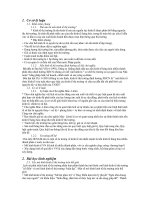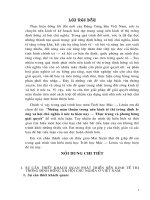Thi nghiem24
Bạn đang xem bản rút gọn của tài liệu. Xem và tải ngay bản đầy đủ của tài liệu tại đây (1.55 MB, 53 trang )
<span class='text_page_counter'>(1)</span>THÍ THÍ NGHIỆM NGHIỆM 10 10. Copyright Steven Bottle, Chemistry, QUT, 1995.
<span class='text_page_counter'>(2)</span> 1.Phản ứng giữa carbon và oxy C + O2 CO2. C. O2. +. Copyright Steven Bottle, Chemistry, QUT, 1995.
<span class='text_page_counter'>(3)</span> C. Copyright Steven Bottle, Chemistry, QUT, 1995. O2.
<span class='text_page_counter'>(4)</span> Copyright Steven Bottle, Chemistry, QUT, 1995.
<span class='text_page_counter'>(5)</span> Copyright Steven Bottle, Chemistry, QUT, 1995.
<span class='text_page_counter'>(6)</span> Copyright Steven Bottle, Chemistry, QUT, 1995.
<span class='text_page_counter'>(7)</span> Copyright Steven Bottle, Chemistry, QUT, 1995.
<span class='text_page_counter'>(8)</span> Copyright Steven Bottle, Chemistry, QUT, 1995.
<span class='text_page_counter'>(9)</span> CO2. phân tử cacbon chưa phản ứng. Copyright Steven Bottle, Chemistry, QUT, 1995.
<span class='text_page_counter'>(10)</span> Copyright Steven Bottle, Chemistry, QUT, 1995. CO2. 1.
<span class='text_page_counter'>(11)</span> 2.Phản ứng giữa Natri và oxy 4Na + O2 2Na2O. + O2 Na. Copyright Steven Bottle, Chemistry, QUT, 1995. 1.
<span class='text_page_counter'>(12)</span> to. + O2 Na. Copyright Steven Bottle, Chemistry, QUT, 1995. 1.
<span class='text_page_counter'>(13)</span> Copyright Steven Bottle, Chemistry, QUT, 1995. 1.
<span class='text_page_counter'>(14)</span> phân tử Natri chưa phản ứng. Copyright Steven Bottle, Chemistry, QUT, 1995. phân tử Natrioxit. 1.
<span class='text_page_counter'>(15)</span> Copyright Steven Bottle, Chemistry, QUT, 1995. phân tử Natrioxit. 1.
<span class='text_page_counter'>(16)</span> Thí nghiệm nghiệm 10 10 Thí Phản ứng giữa đồng(II) oxit và hyđro. Copyright Steven Bottle, Chemistry, QUT, 1995. 1.
<span class='text_page_counter'>(17)</span> H2 H 2. Copyright Steven Bottle, Chemistry, QUT, 1995. CuO CuO. 1.
<span class='text_page_counter'>(18)</span> CuO CuO. H2 H 2. +. Copyright Steven Bottle, Chemistry, QUT, 1995. 1.
<span class='text_page_counter'>(19)</span> ttoo. +. Copyright Steven Bottle, Chemistry, QUT, 1995. 1.
<span class='text_page_counter'>(20)</span> oo t t. H2. Copyright Steven Bottle, Chemistry, QUT, 1995. CuO. 2.
<span class='text_page_counter'>(21)</span> Copyright Steven Bottle, Chemistry, QUT, 1995. 2.
<span class='text_page_counter'>(22)</span> Copyright Steven Bottle, Chemistry, QUT, 1995. 2.
<span class='text_page_counter'>(23)</span> Copyright Steven Bottle, Chemistry, QUT, 1995. 2.
<span class='text_page_counter'>(24)</span> Copyright Steven Bottle, Chemistry, QUT, 1995. + Cu H2O. 2.
<span class='text_page_counter'>(25)</span> 4.Phản ứng giữa hydro và oxy 2H2. +. O2. 2H2O. + 2H2. Copyright Steven Bottle, Chemistry, QUT, 1995. O2. 2.
<span class='text_page_counter'>(26)</span> to. + 2H2. Copyright Steven Bottle, Chemistry, QUT, 1995. O2. 2.
<span class='text_page_counter'>(27)</span> to. Copyright Steven Bottle, Chemistry, QUT, 1995. 2.
<span class='text_page_counter'>(28)</span> Copyright Steven Bottle, Chemistry, QUT, 1995. 2.
<span class='text_page_counter'>(29)</span> Copyright Steven Bottle, Chemistry, QUT, 1995. 2.
<span class='text_page_counter'>(30)</span> Copyright Steven Bottle, Chemistry, QUT, 1995. 2H2O. 3.
<span class='text_page_counter'>(31)</span> 5.Phản ứng giữa sắt và axit clohydric Fe +. 2HCl. FeCl2. +. H2. +. Fe. Copyright Steven Bottle, Chemistry, QUT, 1995. 2HCl. 3.
<span class='text_page_counter'>(32)</span> +. Fe. Copyright Steven Bottle, Chemistry, QUT, 1995. 2HCl. 3.
<span class='text_page_counter'>(33)</span> Copyright Steven Bottle, Chemistry, QUT, 1995. 3.
<span class='text_page_counter'>(34)</span> Copyright Steven Bottle, Chemistry, QUT, 1995. 3.
<span class='text_page_counter'>(35)</span> Copyright Steven Bottle, Chemistry, QUT, 1995. 3.
<span class='text_page_counter'>(36)</span> Copyright Steven Bottle, Chemistry, QUT, 1995. 3.
<span class='text_page_counter'>(37)</span> Copyright Steven Bottle, Chemistry, QUT, 1995. 3.
<span class='text_page_counter'>(38)</span> Copyright Steven Bottle, Chemistry, QUT, 1995. 3.
<span class='text_page_counter'>(39)</span> Copyright Steven Bottle, Chemistry, QUT, 1995. 3.
<span class='text_page_counter'>(40)</span> Copyright Steven Bottle, Chemistry, QUT, 1995. 4.
<span class='text_page_counter'>(41)</span> H CH3. Chirality. * *. . H CH3 H OH. * *. H OH. Take the molecule on the left and make its mirror image. H CH3 * *. H CH3 H OH. H HO. * *. Copyright Steven Bottle, Chemistry, QUT, 1995. 4.
<span class='text_page_counter'>(42)</span> H CH3. Chirality. * *. . H CH3 *. H. *. OH. H OH. Flipping the reflection does not give a super-imposable compound! H CH3. H CH3 * *. H OH. H HO. * *. Copyright Steven Bottle, Chemistry, QUT, 1995. H CH3 * *. H OH. 4.
<span class='text_page_counter'>(43)</span> Chirality. H CH3 * *. . H CH3 *. H. *. OH. H OH. Flipping the reflection does not give a super-imposable compound! H CH3. . The methyl groups do not line up.. Copyright Steven Bottle, Chemistry, QUT, 1995. * *. H OH. 4.
<span class='text_page_counter'>(44)</span> Chirality. H CH3 * *. . . H CH3 H OH. * *. H OH. These are examples of yet another type of isomer! They are optically active (ie chiral). But they are not mirror images. They are called diasteriomers.. Copyright Steven Bottle, Chemistry, QUT, 1995. 4.
<span class='text_page_counter'>(45)</span> Chirality. H CH3 * *. . H OH. * *. H OH. The situation is actually a little more complex as there is another chiral carbon in the molecule. . . H CH3. Can you find it?. For ‘n’ chiral carbons in a molecule there are up to ‘2n’ optical isomers.. Copyright Steven Bottle, Chemistry, QUT, 1995. 4.
<span class='text_page_counter'>(46)</span> H CH3. Chirality. Copyright Steven Bottle, Chemistry, QUT, 1995. * *. H CH3 H OH. * *. H OH. 4.
<span class='text_page_counter'>(47)</span> Chirality - Racemates . . What happens when HBr is added to the alkene 1-butene? An addition reaction occurs. The product is 2-bromobutane. . . (The Markovnikov product). Is the product optically active?. Copyright Steven Bottle, Chemistry, QUT, 1995. 4.
<span class='text_page_counter'>(48)</span> Chirality - Racemates . The result is an addition which gives a chiral carbon.. Copyright Steven Bottle, Chemistry, QUT, 1995. 4.
<span class='text_page_counter'>(49)</span> Chirality - Racemates . The result is an addition which gives a chiral carbon. H C H. C. CH2 CH3. HBr. H. Copyright Steven Bottle, Chemistry, QUT, 1995. H Br H C C* CH2 CH3 H H. 4.
<span class='text_page_counter'>(50)</span> Chirality - Racemates . But in fact the addition can occur from either side! H C H. . C. CH2 CH3. HBr. H. H Br H C C* CH2 CH3 H H. H Both compounds H are optically active, but the mixture is not.. Copyright Steven Bottle, Chemistry, QUT, 1995. C. CH2 CH3 * C H. H Br. 5.
<span class='text_page_counter'>(51)</span> Chirality - Racemates . . . A mixture that contains both enantiomers is called racemic. Most chemical reactions produce racemic mixtures. Most biochemical reactions produce only one optical isomer and are not racemic.. Copyright Steven Bottle, Chemistry, QUT, 1995. 5.
<span class='text_page_counter'>(52)</span> Chirality - Review . . . Compounds can be chiral if there is a carbon which has four different groups. Chiral compounds are said to be optically active as they can rotate the plane of polarised light. Enantiomers are non superimposable mirror images.. Copyright Steven Bottle, Chemistry, QUT, 1995. 5.
<span class='text_page_counter'>(53)</span> Chirality - Review . . Diasteriomers are optically active compounds which are not mirror images of each other. Diasteriomers must have at least two chiral carbons.. Copyright Steven Bottle, Chemistry, QUT, 1995. 5.
<span class='text_page_counter'>(54)</span>






